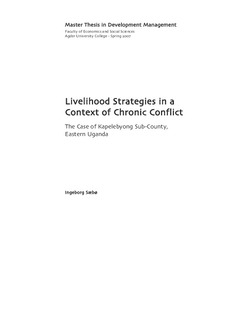| dc.description.abstract | The livelihoods of people in Kapelebyong Sub-County in Eastern Uganda have been severely
affected by insecurity during the last 27 years. This thesis assesses the livelihood strategies
currently employed by Internally Displaced Persons in three camps in the sub county, and the
effects of insecurity on the livelihood strategies that people pursue. Further, it looks at the
environmental and sociocultural consequences of the insecurity and encampment, with
particular emphasis on gender. Lastly, the study assesses the relationship between the
livelihood strategies employed by the IDPs and the interventions by NGOs and government
agencies.
The sustainable livelihoods framework is the theoretical framework which has been the point
of departure in collecting and analyzing the data. However, this framework does not
adequately address the special needs of a population that has lived with chronic conflict for
almost three decades. In addition to the sustainable livelihoods framework, the thesis
discusses chronic conflict and protracted internal displacement in order to present a more
accurate way of understanding the situation of the people in Kapelebyong.
Fieldwork was carried out in Kapelebyong Sub-County in January and February 2007. A
qualitative research methodology is used, with emphasis on household interviews, group
discussions, key informant interviews and observation.
The study finds that all respondents have lost important assets due to insecurity and
displacement, and have restricted access to land, which is their most important productive
asset. The loss of assets has resulted in high levels of poverty and food insecurity. Insecurity
and encampment has led to sociocultural changes in the society, especially in regard to gender
relations and family issues. A few NGOs work in the area with different projects designed to
help the IDPs improve their livelihoods. These projects are generally seen as beneficial by the
communities, but their scope is limited. The government is responsible for education, health
care and security. However, the quality of these services is poor, and thus the population is
left to their own devices in order to secure quality health care and education. The constant
security threat leads to a very uncertain situation, and the IDPs are not able to utilize their
assets effectively.
Vulnerability of the asset base as a result of chronic insecurity is one of the major challenges
facing the IDPs in Kapelebyong. As a result of this, people have started employing livelihood
strategies which were non-existent or rare earlier. This has led to quite dramatic changes,
especially with regard to gender roles. To understand sociocultural change as a result of
protracted displacement and chronic conflict is important in order to understand the livelihood
strategies available to people. This is an aspect which is rarely discussed in the literature on
livelihoods, but which is of major importance in the study area. | en |
